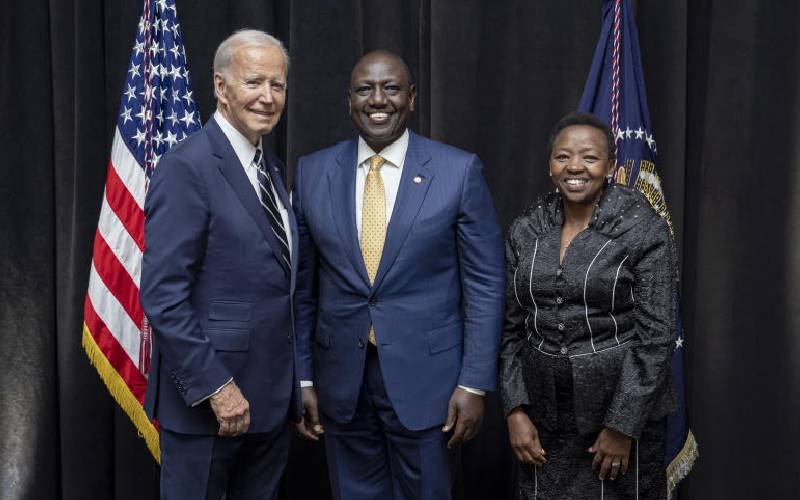By Anyang Nyongo
NAIROBI, KENYA: Following my article last week on industrialisation, I received comments from two Kenyans who are very angry: Ms Jemima Nyagah and Mr Kamau Kaniaru. Both strongly felt we have had a false start in our industrialisation process, and we are probably still digging the hole deeper. After consulting with them, I received permission to share their anger with my readers.
To expand industry, argued Kamau, we must first get very angry. We import toothpicks, pangas, sickles, axes, raw garlic, and Ginger; not to mention engineering and construction technology from China. Garlic? Ginger? Shame on us, writes Kamau. Colgate tooth paste comes from South Africa. Mortein Doom cockroach killer from Sharjah! We need a day of National Shame, concludes Kamau.
With reference to your article in todays’ paper, wrote Jemima, I agree that it would be excellent to have tools from Kenya in our stores or cotton clothing made locally. I worked as a Brand Manager for Sarova Group years ago. I set up artisans under pretty tents at the camps who would carve soapstone into whatever the tourist desired, or make a belt with beads tailored to the clients’ request. The most fascinating part of these projects was, aside from the fabulous skills, the tourists awe at the crude materials used to create these works of art. But those crude tools and perhaps the government’s lack of understanding of what tools would help are exactly what restricts our development.
The handicrafts industry under an online handicrafts site, for example Etsy, turned over $180 million gross profit last year. A fabulous opportunity for cottage industry. Within minutes of registering an online shop sellers have access to 39 million visitors per month. The issue as I see it is not the unwillingness of either the consumer or the creator but a complete lack of support from our import-export promotion institutions and obviously from the WTO. A person/company is only as good as their tools and their knowledge. Any consumer cannot afford to buy sub standard goods. The sub standard goods are a direct result of a lack of affordable quality tools and materials allowed into the country.
Artists for example are charged a premium tax rate for import of materials; this consigns them to the use of materials as factor inputs in their work, which may not help in product innovation. This seriously damages us against a global market.
Searching for local cotton (as I am sure many talented local clothing designers do) I finally found one small shop at the end of Biashara Street: Rift Valley Textiles. However, I wanted something different to the usual kitenge. The spokesman stated that they had had “great results with some dyes imported from New York, but the cost of import was too high.”
He seemed deeply frustrated that they couldn’t take their cottons up to the next level. How would a broad colour palette work for RVT? Through diversification of their product they in turn would enable local designers to diversify their own products, increase local trade and then be able to afford essential machinery, conditions, infrastructure and buy machines. Of course there are mordants that maybe made with natural materials and many online degrees available, which raises the dynamics of introducing education and specialisation through online degrees to help develop the home/ cottage industries. Whilst the UK operates the Open University where a degree is paid back after the degree, we have yet to innovate the UK way.
The Government needs first to conduct a review, consulting the industries and artisans on the tools and skills they need to develop and enabling them to grow. Examples of interest are: High quality leather working tools, cotton fabrics dyed using natural dye extracts, and dyeing for fashion and textiles.
We can’t work without the tools either locally or internationally. Every time I pass Dagoretti Corner my heart bleeds for it could be a bustling arts community. If they can manage with all the restrictions they have at the moment, imagine what money and industry could be created with the right help? There is also fear over diversification of product with the economy virtually enslaving the talent of potential entrepreneurs. For example at Dagoretti Corner there coexists the plant world on one side and the iron workers on the other. These two need an organic and symbiotic relationship that should underpin their expansion and reproduction.
Those were the sentiments of the two Kenyans concerned about the direction of our industrialisation process, which could, they further infer, have had false process. But we need not continue like this. At independence we approached the problem of our infant industries by implementing a policy of import substitution industrialisation. But we soon found out that some of our entrepreneurs exploited this set up by engaging in non-competitive and sub- standard production, overcharging consumers and failing to innovate and expand. To cure this malaise, we dismantled the import barriers, thereby exposing our industries to adverse competition from products manufactured under subsidised conditions.
I brought this problem to the attention of some businessmen who reminded me that the problem of our domestic industries is three pronged: Cost of transport, energy and capital. Relying on road transport and not railways or maritime transport is a recipe for making sure that the factor inputs for a manufacturer will always be higher in Kenya than China.
In the final analysis the responsibility lies squarely with those of us who make public policy and laws. I am not in any way advocating a return to import substitution industrialisation: that is virtually impossible. But supporting our domestic industries by accessing capital affordably made available in our development finance institutions would provide a positive way forward. Likewise energy can be made affordable if the parastatals engaged in production, transmission and sale had been more conscious of supporting end users than in repaying their expensive loans, quite often padded with kickbacks.
Stay informed. Subscribe to our newsletter
 The Standard Group Plc is a
multi-media organization with investments in media platforms spanning newspaper
print operations, television, radio broadcasting, digital and online services. The
Standard Group is recognized as a leading multi-media house in Kenya with a key
influence in matters of national and international interest.
The Standard Group Plc is a
multi-media organization with investments in media platforms spanning newspaper
print operations, television, radio broadcasting, digital and online services. The
Standard Group is recognized as a leading multi-media house in Kenya with a key
influence in matters of national and international interest.
 The Standard Group Plc is a
multi-media organization with investments in media platforms spanning newspaper
print operations, television, radio broadcasting, digital and online services. The
Standard Group is recognized as a leading multi-media house in Kenya with a key
influence in matters of national and international interest.
The Standard Group Plc is a
multi-media organization with investments in media platforms spanning newspaper
print operations, television, radio broadcasting, digital and online services. The
Standard Group is recognized as a leading multi-media house in Kenya with a key
influence in matters of national and international interest.








